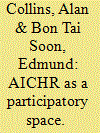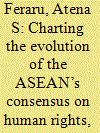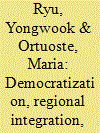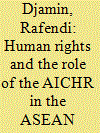|
|
|
Sort Order |
|
|
|
Items / Page
|
|
|
|
|
|
|
| Srl | Item |
| 1 |
ID:
186605


|
|
|
|
|
| Summary/Abstract |
The ASEAN Intergovernmental Commission on Human Rights (AICHR) is often regarded unfavourably, depicted at best as irrelevant in the battle to promote and protect human rights in Southeast Asia, and at worst, complicit in the abuse of human rights by its silence in the face of the region's human rights' tragedies. While AICHR has many limitations, we regard it as a work-in-progress, evolving as it was always meant to. To understand this evolution, we conceive of AICHR as a participatory space in which contestation of what AICHR can, and cannot, do is being undertaken by its Representatives. This contestation includes exposing its secretive face of power by revealing: the space human rights can be discussed in; who can participate and who is excluded in this discussion; and how malleable the norms that operate within this space are to change. The latter aspect of contestation engages with the thorny ‘problem’ of consensus. We argue that the presence of Representatives from outside of government has introduced a desire in AICHR for change; a dynamism that makes it a participatory space witnessing contestation that has the potential to enable AICHR to evolve. A space, therefore, that for all its shortcomings is worth watching.
|
|
|
|
|
|
|
|
|
|
|
|
|
|
|
|
| 2 |
ID:
192168


|
|
|
|
|
| Summary/Abstract |
This article provides a comprehensive understanding of the roles and functions of ASEAN’s human rights regime by building on widely documented, consistent findings relating to the purpose of the association and the nature of its human rights institutions. In particular, the paper starts by emphasizing that, despite continuing debate over the nature and achievements/failures of the regional grouping, scholarship tends to converge on the two important aspects: ASEAN’s normative framework and its long-standing practice of ‘quiet diplomacy’ are designed to reassure incumbent governments weary of unwanted interference in internal affairs; and regional human rights institutions are primarily ASEAN bodies. These findings are formulated as assumptions guiding the analysis of the association’s human rights rhetoric and practice, which centers on the evolution of intergovernmental consensus, the role of the ASEAN Intergovernmental Commission on Human Rights (AICHR) in advancing this consensus, and an assessment of ASEAN responses to gross violations perpetrated or supported by governing elites. This latter examination details regional responses to the 2014 military coup in Thailand, Philippines’ brutal and largely extrajudicial ‘war on drugs’, the Rohingya genocide, and the 2021 military coup in Myanmar and ensuing violence.
|
|
|
|
|
|
|
|
|
|
|
|
|
|
|
|
| 3 |
ID:
131352


|
|
|
|
|
| Publication |
2014.
|
| Summary/Abstract |
The establishment of the Association of Southeast Asian Nations' (ASEAN) Intergovernmental Commission on Human Rights (AICHR) is extremely puzzling, because many ASEAN members have never been strong supporters of human rights, nor have they been advocates for intervening in the name of human rights. Why did ASEAN members, then, agree to establish the AICHR? We argue that the AICHR is the result of two factors: democratization in key regional countries and the intensifying effort of regional integration in the form of the ASEAN Community project. The former factor engendered key agents for pro-human rights initiatives and set the direction of human rights development within ASEAN. The latter factor weakened the old norms of the ASEAN Way and engendered new regional norms such as good governance and accountability, which were conducive to the development of human rights. It also provided persuasive power based on a shared sense of collective purpose in eliciting agreement from the authoritarian members for the AICHR. We support our argument with the analysis of all ASEAN vision statements and its ministerial meeting statements from 1967 to 2010 as well as our own interviews. The analysis shows that the emergence of new regional norms was closely associated with the development of the ASEAN Community project, and this normative change resulted in a different view of human rights, whose promotion would positively affect regional integration and stability. Our argument suggests a different perspective of a regional human rights mechanism essentially as a regional body reflecting regional norms and values.
|
|
|
|
|
|
|
|
|
|
|
|
|
|
|
|
| 4 |
ID:
165869


|
|
|
|
|
| Summary/Abstract |
Whether it is the persecution of the Rohingya, the disappearance of human rights activists, the general limiting of freedom of speech across the region, or the resumption of the arbitrary use of the death penalty, Southeast Asia can be said to be facing a human rights crisis. This human rights crisis is though occurring at a time when the region’s institution, the Association of Southeast Asian Nations (ASEAN), has never been so interested in human rights. After a lengthy period of time in which ASEAN either ignored, or paid lip service to human rights, the Association has created a human rights body – the ASEAN Intergovernmental Commission on Human Rights (AICHR) – and adopted an ASEAN Human Rights Declaration (AHRD). In this article, I utilize the Spiral Model to explain how, when ASEAN member states are regressing in their commitment to human rights, an intergovernmental body continues to promote their commitment and lay the groundwork for their compliance.
|
|
|
|
|
|
|
|
|
|
|
|
|
|
|
|
| 5 |
ID:
101934


|
|
|
|
|
|
|
|